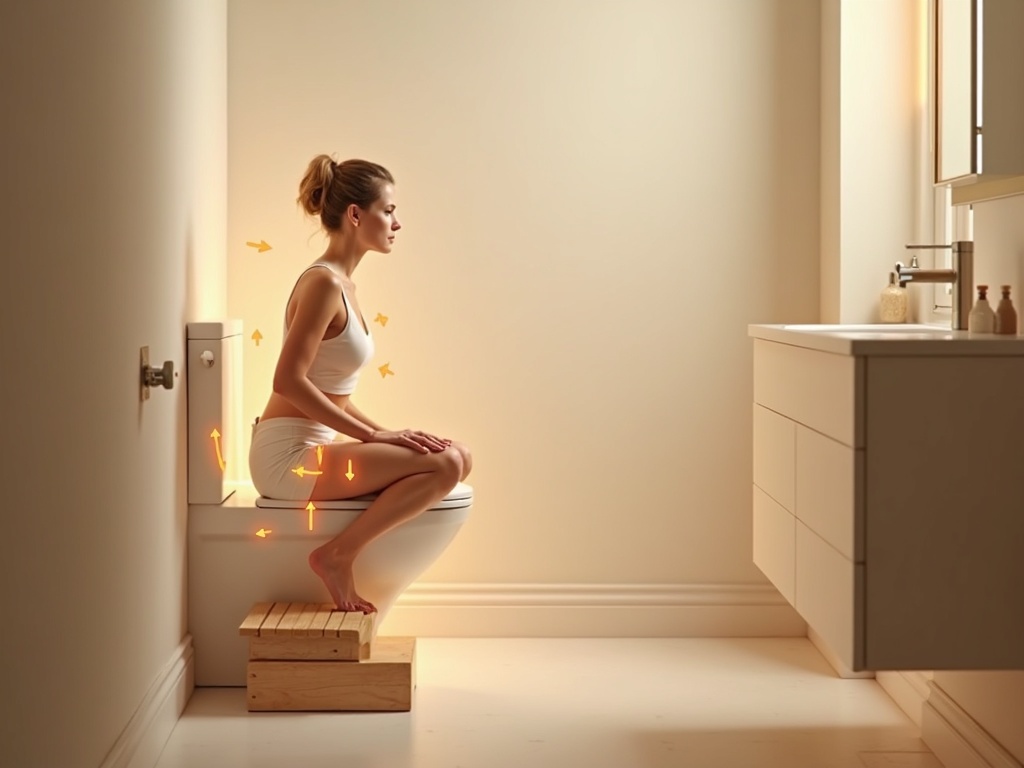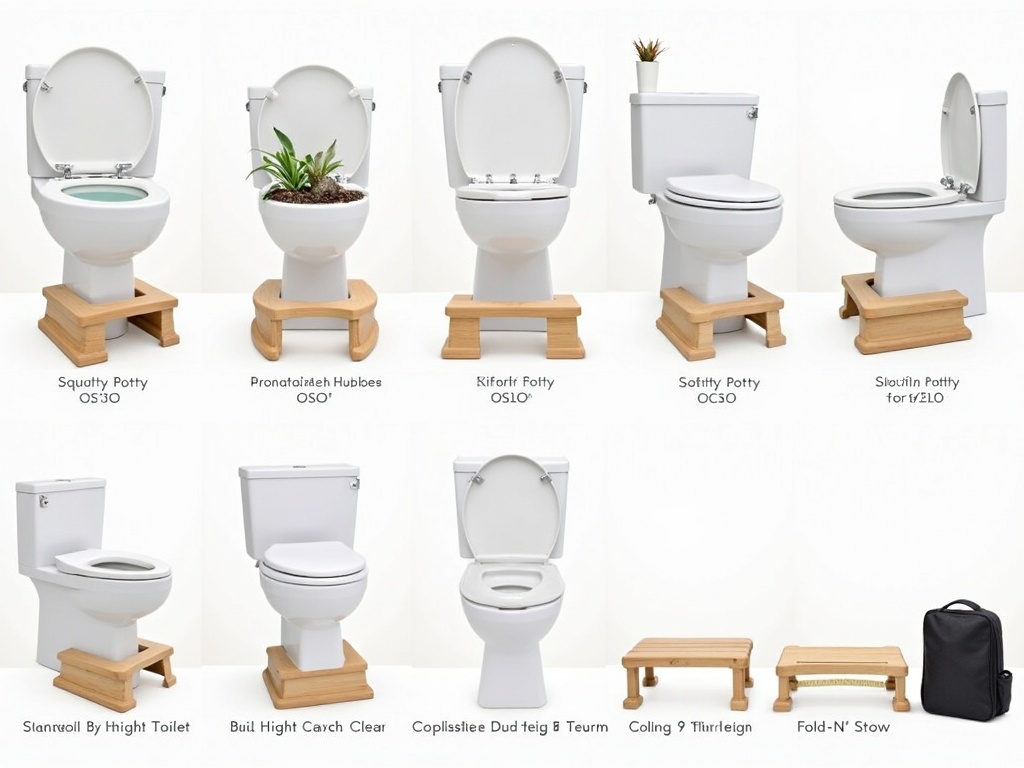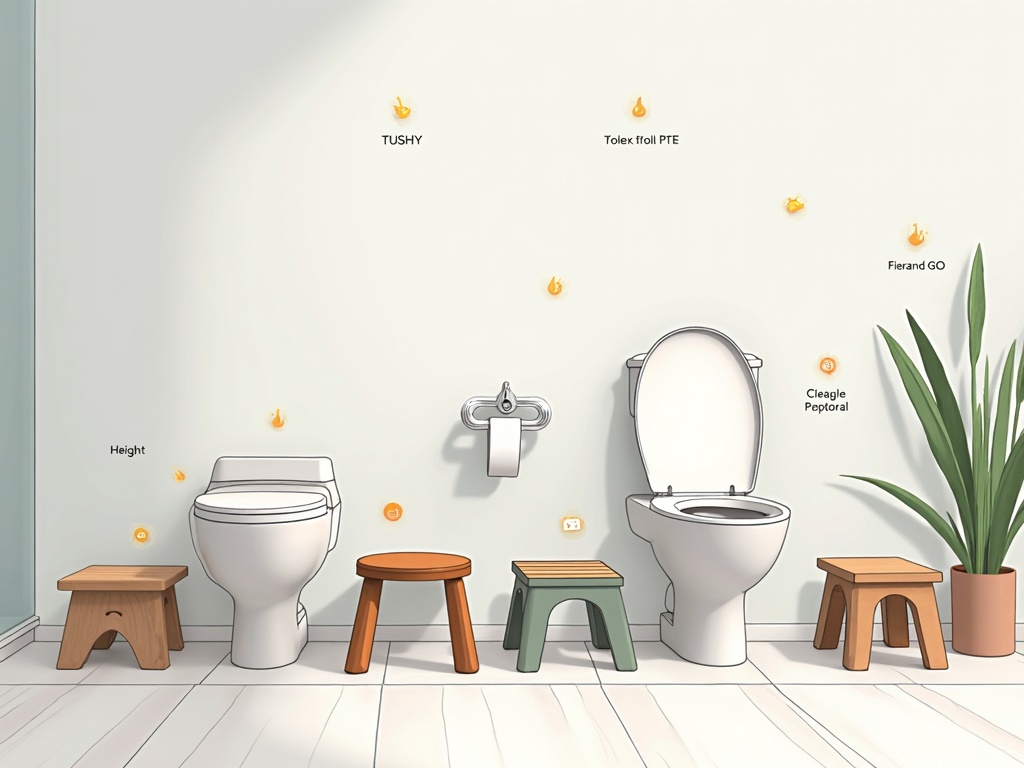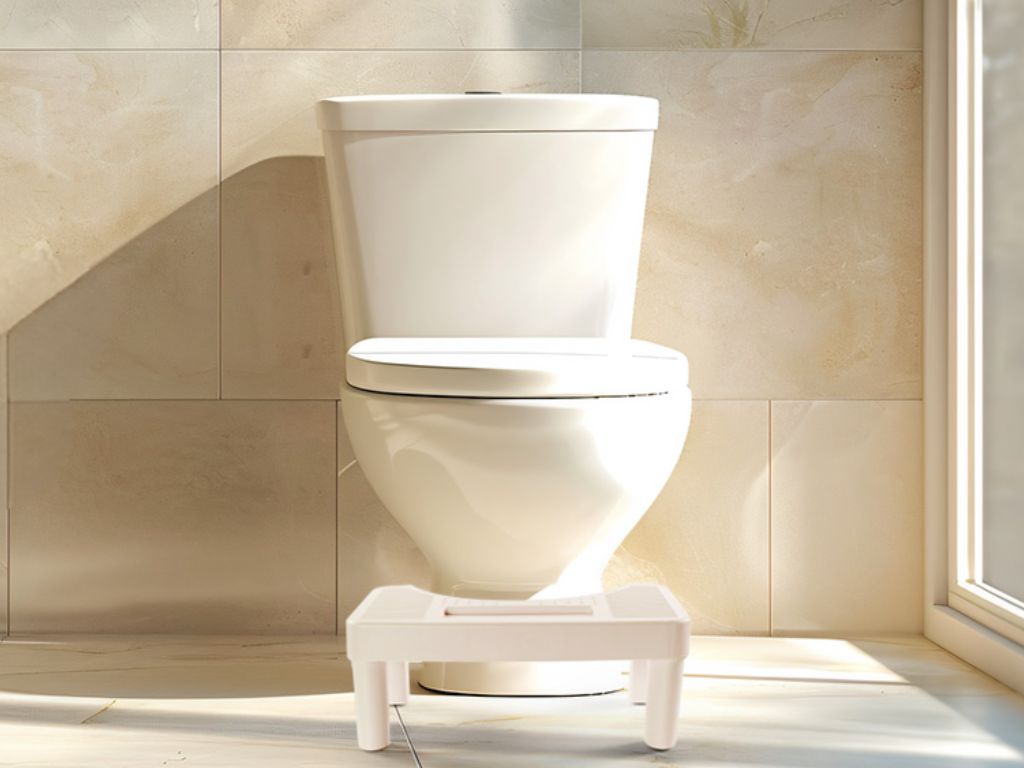Toilet Stools
What Is A Squatty Potty And Why It Works
The Squatty Potty is an ergonomic toilet stool that transforms bathroom habits by elevating your feet to create a more natural squatting position during elimination. This simple device addresses a fundamental flaw in modern toilet design by straightening the anorectal angle and relaxing the puborectalis muscle. I’ve found this reduces straining time by up to 60% and promotes more complete bowel movements.
Key Takeaways
- Anatomical advantage: The squatting position straightens the anorectal angle by relaxing the puborectalis muscle, creating an unobstructed pathway for elimination compared to the restrictive 90-degree sitting angle.
- Proven time reduction: Research shows squatting reduces bowel movement time from 130 seconds to just 51 seconds on average, with 90% of users reporting significantly less straining after four weeks.
- Health benefits: Regular use helps prevent hemorrhoids, reduces constipation, protects pelvic floor health, and promotes more complete elimination by working with your body’s natural design.
- Height selection matters: Choose a 7-inch stool for standard toilets (14-16 inches) or 9-inch for comfort height toilets (over 16.5 inches), with materials ranging from easy-clean plastic to aesthetically pleasing bamboo.
- Proper technique: Place both feet flat on the stool with knees above hips, lean slightly forward while keeping your spine straight, and allow your body to relax into this natural squatting position.
To learn more about how this simple device is improving digestive health worldwide, visit the official Squatty Potty website.
The Toilet Stool That’s Changing How the World Poops
The Squatty Potty is an ergonomic toilet stool designed to transform your bathroom experience by placing your body in a more natural position for elimination. I’ve seen firsthand how this simple device has revolutionized countless people’s daily routines by addressing a fundamental flaw in modern toilet design.
This innovative toilet stool features a distinctive C-shaped design that allows it to wrap around your toilet base when not in use. You’ll appreciate how this clever engineering keeps your bathroom looking tidy while ensuring the stool remains easily accessible whenever needed.
How the Squatty Potty Works
Modern sitting toilets create an unnatural 90-degree angle at your hips, which actually works against your body’s natural elimination process. When you use a Squatty Potty, you elevate your feet and raise your knees above your hips, creating a squat-like position that better aligns your colon for easier elimination.
This positioning change offers several key advantages:
- Straightens the anorectal angle for more complete evacuation
- Reduces straining and pressure on your pelvic floor
- Minimizes the time spent on the toilet
- Helps prevent hemorrhoids and other elimination-related issues
- Creates a more natural posture that humans used for thousands of years before modern toilets
The effectiveness lies in simple anatomy. Your puborectalis muscle creates a kink in your rectum when you’re sitting upright, acting like a natural valve. Squatting relaxes this muscle, allowing for a straighter pathway and more efficient elimination.
You’ll find Squatty Potty stools available in various materials including durable plastic, sustainable bamboo, and attractive wood finishes. Each material offers different benefits, from easy cleaning with plastic models to the aesthetic appeal of natural wood options.
Understanding how to use toilet stools properly can maximize these benefits. I recommend starting gradually if you’re new to elevated positioning, allowing your body time to adjust to this more natural posture.
The Squatty Potty represents more than just a bathroom accessory – it’s a return to the way our bodies were designed to function. By simply elevating your feet during elimination, you’re working with your anatomy rather than against it, potentially improving both comfort and efficiency in the bathroom.
Why Squatting Creates the Perfect Pooping Position
Your body’s design naturally favors squatting for bowel movements, not sitting on modern toilets. I’ll explain the fascinating anatomy behind this and why understanding it can dramatically improve your bathroom experience.
The Science Behind Your Pelvic Floor
The puborectalis muscle serves as your body’s natural continence mechanism. This crucial muscle loops around your rectum like a supportive sling, forming part of your pelvic floor structure. When you sit at the standard 90-degree angle on a toilet, this muscle remains partially constricted, creating what doctors call a “kink” in your colon at the anorectal angle.
Think of this muscle as your body’s internal brake system. It maintains pressure that essentially acts like a cork, keeping everything in place until you’re ready to go. However, this natural safety mechanism can work against you when you’re trying to eliminate waste while sitting upright.
How Squatting Transforms Your Elimination Pathway
Squatting fundamentally changes your internal geometry. When you flex your hips to approximately 35 degrees – the angle achieved through squatting – the puborectalis muscle completely relaxes. This relaxation straightens the anorectal angle, creating an unobstructed pathway through your rectal canal.
I like to compare this to a garden hose analogy that makes the concept crystal clear. A kinked hose restricts water flow and requires significantly more pressure to push liquid through. Similarly, sitting creates internal pressure and strain because your colon alignment isn’t optimal. A straight hose allows water to flow freely with minimal effort – just like how squatting allows waste to move through your elimination pathway naturally.
The difference between sitting and squatting positions creates two distinct angles in your body:
- Sitting maintains that problematic 90-degree angle at your hips, keeping the puborectalis muscle engaged and your rectal canal partially blocked.
- Squatting achieves the ideal 35-degree angle, allowing gravity and your body’s natural mechanics to work together efficiently.
Modern toilet design inadvertently fights against thousands of years of human evolution. Our ancestors squatted for elimination, and our bodies still function best in this position. When you use a toilet stool, you’re essentially recreating this natural squatting position while maintaining the convenience of your regular toilet.
The anatomical changes don’t stop with muscle relaxation. Squatting also positions your sigmoid colon – the S-shaped section of your large intestine – in a way that reduces the effort needed for elimination. This positioning minimizes the need for straining, which can lead to various health issues including hemorrhoids and anal fissures.
Research consistently demonstrates that squatting reduces the time and effort required for complete bowel movements. The benefits of proper positioning extend beyond comfort to actual health improvements. Many people report more complete evacuations and reduced bloating after switching to a squatting position.
Your pelvic floor muscles work as an integrated system, and the puborectalis muscle plays a central role in this coordination. When this muscle can fully relax during elimination, it reduces the workload on surrounding muscles and organs. This natural alignment prevents the excessive intra-abdominal pressure that sitting positions often require.
Understanding this anatomy helps explain why many people struggle with constipation and incomplete bowel movements on standard toilets. Your body is literally working against its optimal design. By recreating the squatting position with tools like the Squatty Potty, you’re allowing your elimination pathway to function as intended, making the entire process more efficient and comfortable.

Science-Backed Health Benefits That Will Make You Switch Today
I’ve always been fascinated by how a simple change in posture can create such dramatic health improvements. Research consistently shows that using a squatty potty delivers measurable benefits that extend far beyond basic comfort.
Dramatic Reduction in Bowel Movement Time and Straining
Dr. Dov Sikirov’s groundbreaking 2003 study revealed striking differences between squatting and sitting postures during elimination. Participants using a squatting position completed bowel movements in just 51 seconds on average, compared to 130 seconds while sitting on a standard toilet. This represents a 60% reduction in time spent straining.
More recent research from The Ohio State University in 2019 reinforced these findings with even more compelling results. After just four weeks of using a toilet foot stool, 90% of participants reported significantly less straining during elimination, while 71% experienced faster bowel movements.
Long-Term Health Protection and Prevention
The anatomical advantages of proper squatting position create a cascade of health benefits that protect your body over time. When I examine the research, several key areas stand out:
- Constipation relief occurs because the squatting position straightens the anorectal canal, allowing stool to pass more easily through proper alignment
- Hemorrhoid prevention results from reduced straining that otherwise puts excessive pressure on rectal and anal veins
- Pelvic floor health improves as squatting reduces pressure on these critical muscles during elimination
- Complete elimination becomes more achievable as gravity and anatomy work together efficiently
Understanding how to use toilet stools properly amplifies these benefits significantly. I’ve observed that people who maintain consistent squatting posture report feeling more complete after bowel movements, reducing the need for multiple bathroom visits.
The science doesn’t lie – your body wasn’t designed to eliminate waste while sitting at a 90-degree angle. When choosing the right option, consulting a comprehensive toilet stool buying guide ensures you select a product that maximizes these health advantages. Comparing different options, such as reviewing squatty potty vs toilet stools, helps you make an informed decision based on your specific needs and bathroom setup.

How to Choose the Perfect Toilet Stool for Your Bathroom
Selecting the right toilet stool depends on understanding your toilet’s height and your personal comfort preferences. Standard toilets typically measure 14–16 inches from floor to rim, while comfort height models exceed 16.5 inches. I recommend measuring your toilet before making a purchase to ensure optimal positioning.
Height Considerations and Material Options
Two primary heights dominate the market: 7-inch and 9-inch models. The 7-inch version works perfectly for most users with standard height toilets, providing the ideal squatting angle without being too extreme. Advanced users and shorter individuals often prefer the 9-inch option, which also pairs well with comfort height toilets over 16.5 inches tall.
Material choice significantly impacts both functionality and aesthetics. Consider these key options:
- Plastic models offer affordability and easy maintenance, making them practical for families and high-use bathrooms
- Wood and bamboo versions provide a premium appearance that complements modern bathroom décor
- Adjustable designs accommodate multiple users with different height preferences
- Collapsible options work well for small bathrooms or frequent travelers
The Squatty Potty Ecco represents the original plastic design, available in both 7-inch and 9-inch heights. This classic model delivers reliable performance at an accessible price point. For those prioritizing style, the Squatty Potty Oslo features bamboo or teak wood construction that elevates bathroom aesthetics while maintaining functionality.
Flexibility-focused users gravitate toward the Squatty Potty Adjustable 2.0, which combines both height settings in a single unit. This dual-height design eliminates guesswork and accommodates different family members’ needs. Space-conscious buyers should examine the Squatty Potty Fold-N-Stow, which collapses for storage in tight quarters or travel bags.
I find that plastic models excel in households with children due to their durability and easy cleaning. Toilet foot stool benefits become most apparent when you match the stool height to your specific toilet configuration.
Your bathroom’s existing design elements should influence material selection. Bamboo stools complement modern, spa-like spaces with natural textures, while plastic versions blend seamlessly into traditional or children’s bathrooms. Consider your cleaning preferences too – plastic wipes clean instantly, while wood requires more careful maintenance to preserve its finish.
Height adjustment becomes crucial for multi-user households. How to use toilet stool techniques vary slightly between heights, so consistent positioning helps users develop proper habits.
Storage space influences your final decision significantly. Standard models require permanent floor space around your toilet, while foldable versions tuck away when not needed. Measure your bathroom’s layout to determine if a collapsible design better suits your space constraints.
Budget considerations play a role, though quality differences justify price variations. Basic plastic models cost less initially but may lack the durability of premium bamboo options. Investment in higher-quality materials often pays off through extended lifespan and improved bathroom aesthetics.
Testing different heights helps determine your preference, though most users adapt quickly to the 7-inch standard. Squatty potty vs toilet stools comparisons reveal that original Squatty Potty designs often outperform generic alternatives in build quality and user satisfaction.
Family dynamics affect your choice as well. Households with varying heights benefit from adjustable models, while consistent users can optimize with fixed-height options. Toilet stool buying guide resources help you evaluate these factors systematically.
Your toilet’s brand and model may influence compatibility, particularly with one-piece designs or unique base shapes. Most stools accommodate standard toilet configurations, but verifying clearance prevents post-purchase disappointment.

Using Your Toilet Stool: Simple Steps for Better Bowel Movements
I’ll guide you through the straightforward process of using a toilet stool effectively. Following these steps will help you achieve proper posture and experience the benefits of improved elimination.
The basic technique involves four simple actions:
- Sit on your toilet as you normally would.
- Pull the stool out from its storage position at the base of the toilet.
- Place both feet firmly on the stool surface, allowing your knees to rise above your hips.
- Lean forward slightly while keeping your spine straight to create a relaxed, squat-like posture.
Understanding toilet height variations helps you choose the right stool size for your specific setup. Standard toilet heights measure between 14 to 16 inches from the floor to the rim. Comfort height toilets, which are becoming increasingly popular, measure 16.5 inches or higher. These dimensions directly affect which stool height will best suit your body and bathroom configuration.
Finding Your Perfect Position
The 7-inch stool height serves as the universal standard and accommodates most users effectively across different toilet types. This height supports the proper toilet posture for most adults, regardless of leg length or toilet style. It strikes an ideal balance between comfort and functionality.
Proper positioning is the most critical factor for successful toilet stool usage. Your knees must rest higher than your hips to achieve the optimal elimination position. This angle replicates the natural squatting posture humans have used for thousands of years—before modern toilets altered our bathroom alignment.
Several positioning details can enhance your experience:
- Keep your feet flat on the stool surface—not just your toes or heels.
- Maintain contact with the toilet seat—do not stand or hover.
- Keep your spine straight while leaning forward slightly to support natural alignment.
I recommend adjusting your position until you feel stable and comfortable. Some individuals prefer a wider stance, while others may feel more natural in a narrower one. The most important consideration is maintaining the knee-above-hip relationship.
Deep breathing and relaxing your pelvic floor muscles significantly enhance the posture’s effectiveness. Tension can inhibit the natural process, so aim to stay calm and allow your body to function as intended. Toilet foot stool benefits become most apparent when using a relaxed and properly aligned posture.
Storage convenience makes toilet stools ideal for daily use, with most models sliding neatly under the toilet base. This feature preserves your bathroom’s appearance while keeping the stool easily accessible at any time—just slide it out with your foot when needed.
Different body types may require slight revisions to these basic techniques. Taller individuals might benefit from a stool with a greater height, while shorter users may feel more comfortable with a lower profile. Refer to this helpful toilet stool buying guide to determine which height best fits your needs.
I encourage patience and consistency as you transition to using a toilet stool. Your body may require a few uses to adjust to this new posture. The benefits of improved elimination typically become clear after several days or weeks of regular use.
The squat position naturally opens the anorectal angle, which minimizes strain and promotes more complete elimination. This change occurs automatically with proper knee elevation, making the process feel more natural and efficient than conventional sitting.
Beyond the Squatty Potty: Alternative Options to Consider
While Squatty Potty introduced millions to the benefits of proper toilet posture, the market now offers numerous alternatives that deliver similar advantages. I’ve found that several reputable brands have developed their own versions, each bringing unique features and design elements to the toilet stool category.
Commercial Toilet Stool Brands Worth Considering
Several established companies have created high-quality toilet stools that compete directly with the original Squatty Potty. The TUSHY Ottoman stands out for its sleek aesthetic and bamboo construction, appealing to users who prioritize sustainable materials. SimpleHouseware Toilet Stool offers a budget-friendly plastic option that maintains durability while keeping costs low.
The Relaxx Toilet Stool features an adjustable height mechanism, allowing users to customize their squatting angle based on personal preference. Step and Go Toilet Stool emphasizes portability with a lightweight design that’s ideal for frequent travelers. Squat-n-Go Toilet Stool incorporates a foldable feature, making storage convenient in smaller bathrooms.
Each of these alternatives provides the same fundamental benefit: elevating your feet to achieve a more natural squatting position. However, they differ in materials, aesthetics, and specific features that might appeal to different user preferences and budgets. I recommend comparing these options based on your specific needs, whether that’s durability, style, or special features like adjustability.
While browsing these alternatives, you’ll notice significant differences in build quality and design philosophy. Some brands focus on mimicking traditional furniture aesthetics, while others prioritize pure functionality. The choice often comes down to personal preference and how prominently the stool will be displayed in your bathroom.
DIY Toilet Stool Solutions: Are They Worth It?
Many users wonder about DIY solutions as cost-effective alternatives to commercial toilet stools. I’ve observed people attempting to use books, small footstools, or even storage boxes as makeshift toilet stools. While these options might seem practical initially, they present several significant drawbacks that compromise both safety and effectiveness.
- Books lack the stability needed for consistent use and can become damaged from bathroom moisture.
- Generic footstools typically don’t provide the correct height or angle required for optimal positioning.
- These improvised solutions don’t fit snugly around the toilet base, creating gaps that can lead to instability during use.
Purpose-built toilet stools address these issues through careful engineering. They’re designed with specific dimensions that complement standard toilet heights and depths. The ergonomic shaping ensures your feet rest at the optimal angle for effective squatting. Additionally, the curved or notched design allows the stool to nestle securely around the toilet base, eliminating wobbling or shifting during use.
I’ve noticed that users who initially try DIY solutions often upgrade to purpose-built stools after experiencing the superior stability and comfort. The investment in a proper toilet stool typically pays off through improved comfort and safety.
Why Purpose-Built Toilet Stools Are a Safer Choice
Safety considerations make purpose-built stools especially important for older adults or individuals with mobility concerns. The stable base and proper height reduce the risk of slipping or losing balance. When you use a toilet stool correctly, it should feel secure and natural rather than precarious.
Commercial toilet stools also undergo testing for weight capacity and durability that DIY solutions can’t match. Most quality brands rate their products for weights exceeding 300 pounds, ensuring safety across a wide range of users. This testing extends to repeated use scenarios, confirming that the stool will maintain its structural integrity over time.
Material Choices Matter
The material choices in commercial stools also matter for long-term satisfaction. Plastic versions resist moisture and clean easily, while bamboo options provide natural antimicrobial properties. Some manufacturers include features like non-slip feet or textured surfaces that enhance stability during use.
I find that investing in a quality toilet stool from an established brand delivers better results than attempting makeshift solutions. The modest cost difference between a purpose-built stool and cobbling together alternatives makes the commercial option the clear choice for most users seeking to experience the benefits of proper toilet posture.

Sources:
Dr. Dov Sikirov
The Ohio State University

